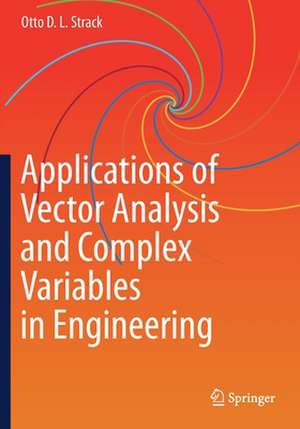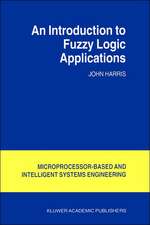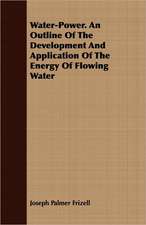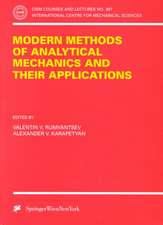Applications of Vector Analysis and Complex Variables in Engineering
Autor Otto D. L. Stracken Limba Engleză Paperback – 20 apr 2021
This textbook presents the application of mathematical methods and theorems to
solve engineering problems, rather than focusing on mathematical proofs. Applications of Vector Analysis and Complex Variables in Engineering explains the mathematical principles in a manner suitable for engineering students, who generally think quite differently than students of mathematics. The objective is to emphasize mathematical methods and applications, rather than emphasizing general theorems and principles, for which the reader is referred to the literature. Vector analysis plays an important role in engineering, and is presented in terms of indicial notation, making use of the Einstein summation convention. This text differs from most texts in that symbolic vector notation is completely avoided, as suggested in the textbooks on tensor algebra and analysis written in German by Duschek and Hochreiner, in the 1960s. The defining properties of vector fields, the divergence and curl, are introduced in terms of fluid mechanics. The integral theorems of Gauss (the divergence theorem), Stokes, and Green are introduced also in the context of fluid mechanics. The final application of vector analysis consists of the introduction of non-Cartesian coordinate systems with straight axes, the formal definition of vectors and tensors. The stress and strain tensors are defined as an application.
Partial differential equations of the first and second order are discussed. Two-dimensional linear partial differential equations of the second order are covered, emphasizing the three types of equation: hyperbolic, parabolic, and elliptic. The hyperbolic partial differential equations have two real characteristic directions, and writing the equations along these directions simplifies the solution process. The parabolic partial differential equations have two coinciding characteristics; this gives useful information regarding the character of the equation, but does not help in solving problems. The elliptic partial differential equations do not have real characteristics. In contrast to most texts, rather than abandoning the idea of using characteristics, here the complex characteristics are determined, and the differential equations are written along these characteristics. This leads to a generalized complex variable system, introduced by Wirtinger. The vector field is written in terms of a complex velocity, and the divergence and the curl of the vector field is written in complex form, reducing both equations to a single one.
Complex variable methods are applied to elliptical problems in fluid mechanics, and linear elasticity.
The techniques presented for solving parabolic problems are the Laplace transform and separation of variables, illustrated for problems of heat flow and soil mechanics. Hyperbolic problems of vibrating strings and bars, governed by the wave equation are solved by the method of characteristics as well as by Laplace transform.
The method of characteristics for quasi-linear hyperbolic partial differential equations is illustrated for the case of a failing granular material, such as sand, underneath a strip footing.
The Navier Stokes equations are derived and discussed in the final chapter as an illustration of a highly non-linear set of partial differential equations and the solutions are interpreted by illustrating the role of rotation (curl) in energy transfer of a fluid.
Partial differential equations of the first and second order are discussed. Two-dimensional linear partial differential equations of the second order are covered, emphasizing the three types of equation: hyperbolic, parabolic, and elliptic. The hyperbolic partial differential equations have two real characteristic directions, and writing the equations along these directions simplifies the solution process. The parabolic partial differential equations have two coinciding characteristics; this gives useful information regarding the character of the equation, but does not help in solving problems. The elliptic partial differential equations do not have real characteristics. In contrast to most texts, rather than abandoning the idea of using characteristics, here the complex characteristics are determined, and the differential equations are written along these characteristics. This leads to a generalized complex variable system, introduced by Wirtinger. The vector field is written in terms of a complex velocity, and the divergence and the curl of the vector field is written in complex form, reducing both equations to a single one.
Complex variable methods are applied to elliptical problems in fluid mechanics, and linear elasticity.
The techniques presented for solving parabolic problems are the Laplace transform and separation of variables, illustrated for problems of heat flow and soil mechanics. Hyperbolic problems of vibrating strings and bars, governed by the wave equation are solved by the method of characteristics as well as by Laplace transform.
The method of characteristics for quasi-linear hyperbolic partial differential equations is illustrated for the case of a failing granular material, such as sand, underneath a strip footing.
The Navier Stokes equations are derived and discussed in the final chapter as an illustration of a highly non-linear set of partial differential equations and the solutions are interpreted by illustrating the role of rotation (curl) in energy transfer of a fluid.
| Toate formatele și edițiile | Preț | Express |
|---|---|---|
| Paperback (1) | 454.16 lei 6-8 săpt. | |
| Springer International Publishing – 20 apr 2021 | 454.16 lei 6-8 săpt. | |
| Hardback (1) | 591.28 lei 6-8 săpt. | |
| Springer International Publishing – 20 apr 2020 | 591.28 lei 6-8 săpt. |
Preț: 454.16 lei
Nou
Puncte Express: 681
Preț estimativ în valută:
86.92€ • 90.40$ • 71.75£
86.92€ • 90.40$ • 71.75£
Carte tipărită la comandă
Livrare economică 14-28 aprilie
Preluare comenzi: 021 569.72.76
Specificații
ISBN-13: 9783030411701
ISBN-10: 3030411702
Pagini: 216
Ilustrații: XIV, 216 p. 86 illus. in color.
Dimensiuni: 178 x 254 mm
Greutate: 0.41 kg
Ediția:1st ed. 2020
Editura: Springer International Publishing
Colecția Springer
Locul publicării:Cham, Switzerland
ISBN-10: 3030411702
Pagini: 216
Ilustrații: XIV, 216 p. 86 illus. in color.
Dimensiuni: 178 x 254 mm
Greutate: 0.41 kg
Ediția:1st ed. 2020
Editura: Springer International Publishing
Colecția Springer
Locul publicării:Cham, Switzerland
Cuprins
1. Vectors in Three-Dimensional Space.- 2. Vector Fields.- 3. Fundamental Equations for Fluid Mechanics.- 4. Integral Theorems.- 5. Coordinate Transformations; Definitions of Vectors and Tensors.- 6. Partial Differential Equations of the First Order.- 7. Partial Differential Equations of the Second Order.- 8. The Elliptic Case: Two Complex Characteristics.- 9. Applications of Complex Variables.- 10. The Parabolic Case: Two Coinciding Characteristics.- 11. The Hyperbolic Case: Two Real Characteristics.- 12. Hyperbolic Quasi Linear Partial Differential Equations.- 13. The Navier-Stokes Equations.- Appendix A. Numerical Integration of the Cauchy Integral.- Appendix B. List of Problems with Page Numbers.
Recenzii
“Geared towards researchers and students seeking to harness mathematical theory for real-world problem-solving, the book offers a wealth of constructive mathematical results, presented through both straightforward and intricate formulas. These formulas are complemented by lucid physical explanations and insightful illustrations, enhancing the reader’s understanding.” (Vladimir Mityushev, zbMATH 1521.76002, 2023)
Notă biografică
Dr. Strack received his PhD from the Technical University of Delft, the Netherlands, in 1973. He joined the Department of Civil Engineering of the University of Minnesota in 1974, where he is currently a professor. Dr. Strack is the original developer of the Analytic Element Method, which is a popular method in groundwater modeling. He is the author of the textbook Groundwater Mechanics (Prentice-Hall, 1989) and the textbook Analytical Groundwater Mechanics (Cambridge University Press, 2017), and a chapter on basic groundwater flow equations in Wiley’s forthcoming Water Encyclopedia. He has authored 44 refereed papers in major journals, is the third recipient of the Lifetime Achievement Award, granted by the Minnesota Groundwater Association, and is a correspondent (foreign member) of the Royal Dutch Academy of Sciences. He is the author of the computer programs SLAEM and MLAEM, used for describing groundwater flow.
Professor Strack has taught groundwater flow and mathematics for engineers for over 45 years and has many years of experience as a consultant.
Professor Strack has taught groundwater flow and mathematics for engineers for over 45 years and has many years of experience as a consultant.
Textul de pe ultima copertă
This textbook presents the application of mathematical methods and theorems to solve engineering problems, rather than focusing on mathematical proofs. Applications of Vector Analysis and Complex Variables in Engineering explains the mathematical principles in a manner suitable for engineering students, who generally think quite differently than students of mathematics. The objective is to emphasize mathematical methods and applications, rather than emphasizing general theorems and principles, for which the reader is referred to the literature.
Caracteristici
Application of indicial notation to vectors and tensors, applying this to fluid mechanics to provide physical interpretation Derivation of complex variables in general terms, viewing them as a non-Cartesian coordinate transformation. This derivation uses the coordinate transformations presented earlier in the text using indicial notation (covariant and contra variant vector components) Applications of the first and second order partial differential equations in engineering. The applications of second order partial differential equations are to fluid mechanics, groundwater flow, heat flow, linear elasticity, and soil mechanics Treatment of singularities in elliptic partial differential equations, and discontinuities in hyperbolic partial differential equations Quasi-linear partial differential equations of the second order Applications of series expansions to obtain solutions to a multitude of elements in problems of groundwater flow. This application is usually given to the students as their final project

























